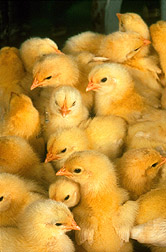This page has been archived and is being provided for reference purposes only. The page is no longer being updated, and therefore, links on the page may be invalid.
Read the magazine story to find out more. |
|
|
Byproducts of Biofuels Could be Economically Viable for Growers
By Alfredo FloresApril 10, 2009
Agricultural Research Service (ARS) scientists have found environmentally and economically sound uses for the byproducts of biofuel production.
Animal scientist William Dozier, formerly with the ARS Poultry Research Unit in Mississippi State, Miss., has been working with colleagues at the ARS Swine Odor and Manure Management Research Unit in Ames, Iowa, and Iowa State University (ISU) to find ways to supplement animal diets with glycerin. Glycerin, a biofuel byproduct, contains energy-providing nutrients for animals.
Dozier and ISU colleague Kristjan Bregendahl evaluated the use of glycerin supplements in poultry feed. Dozier primarily dealt with broilers, which are chickens raised specifically for meat production, and gave glycerin-supplemented poultry feed to broilers that were 7 to 45 days old.
Dozier evaluated the apparent metabolizable energy (AME) intake—a standard measure of energy—for the study group and for a control group that ate a standard diet. The youngest chicks, aged 7 to 10 days, showed a higher AME intake than the control group. However, the two groups showed no significant differences in the amount of feed they consumed, body weight, or the amount of energy lost in feces and urine (energy excretion).
The second group of broilers, aged 21 to 24 days old, that consumed glycerin feed supplements showed no difference in body weight, energy excretion, and AME. However, their feed intake and the amount of energy provided by the diet intake (gross energy) increased when glycerin supplementation increased. The oldest broilers, aged 42 to 45 days old, showed increases in feed consumption, gross energy, and AME.
Dozier notes that from a nutritional standpoint, this technology can serve as an alternative dietary energy source that could result in lower feed costs. Swine and poultry producers are very interested in supplementing livestock feed with glycerin, in part because the corn grain and soybeans that used to be fed to livestock are now being used for biofuel production. This way, the crops can be used for both biofuels and for livestock feed.
Read more about this research in the April 2009 issue of Agricultural Research magazine.
ARS is the principal intramural scientific research agency of the U.S. Department of Agriculture.

